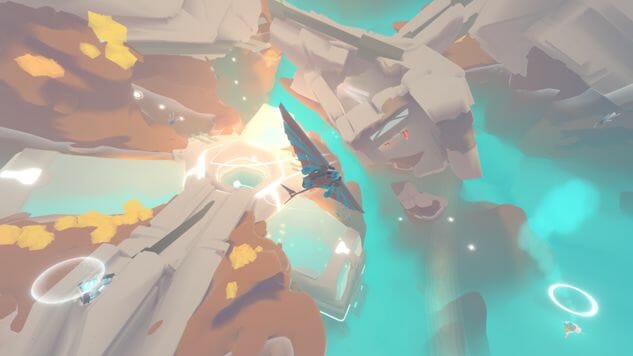
The best thing about Thatgamecompany’s Journey is its silence. There’s no dialogue, no text, no backstory or narration—just a weird, lonely world to get lost in and a beautiful score to keep you company. Whatever depth or emotion players find in that game largely comes down to the decision to avoid coherent language. It’s a master class in “show, don’t tell,” in a way that only videogames can accomplish.
It’s a lesson PolyKnight Games should have heeded while making Innerspace. The graceful flying game takes place in a world as gorgeous and esoteric as the desert wastes of Journey, with crumbling ruins both above and beneath large seas, and withered, unknowable banners flapping in the breeze. As you pilot your mapmaker through the sky and water, collecting a variety of baubles, you’ll learn more about this dying world and the demigods that once ruled over it, but not primarily through observation. You’ll read about it in too-long scrolls of text from your computer-controlled partner, a boat that idles while you do all the hard work. It probably uses that down time to practice its stultifying speeches.
Innerspace isn’t confident enough in itself or its world to embrace ambiguity. That, in turn, robs it of some of its power. I haven’t finished the game, so it’s possible (possibly even likely) that it starts to welcome ambiguity as it progresses, but initial impressions are invaluable, and the early moments of Innerspace are too concerned with clunky exposition and awkward lore. It answers questions before the player can even have a chance to ask them—questions that the player would probably never care to ask—and the answers are too often familiar and too easily dismissed.
The text windows also undermine the physicality of Innerspace. Interrupting its almost constant motion to unspool a page or two of static monologue hinders the dancerly flow that is the game’s greatest attribute. The free range flight through these beautiful environments almost feels like painting in long, supple, effortless strokes, and exploring this world with such elegance is far more alluring than collecting orbs or uncovering bits of old, broken technology. Pausing that motion so your seafaring friend can explain that technology ruins the game’s spell as much as those words themselves. It’d be like if another Thatgamecompany game that clearly influenced Innerspace, in this case the sublime Flower, constantly corralled the wind that you use to interact with nature to explain botany to you.
There’s great beauty in Innerspace, from its vibrant colors and weathered surroundings, to the graceful lines it lets you cut through the sky. It has a strong sense of place, and gives you good reason to explore that space. It also has those unnecessary words regularly needling through its sense of mystery. It would be a stronger game if it knew to stay quiet.
Garrett Martin edits Paste’s comedy and games sections. He’s on Twitter @grmartin.